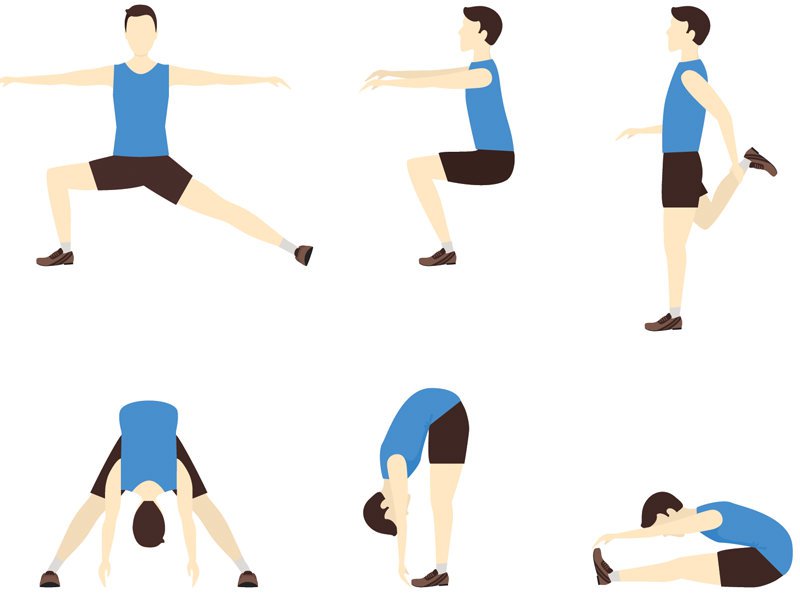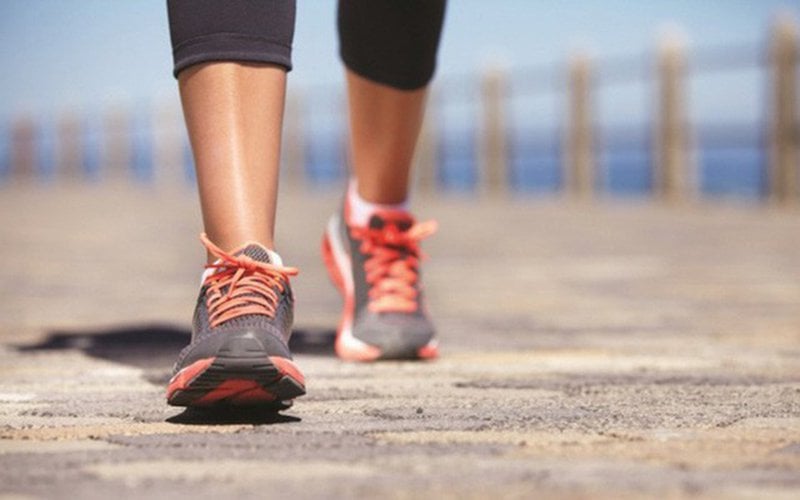How to run without getting tired?
This is an automatically translated article.
Jogging every day has many health benefits such as helping to lose weight, improve heart health,... If jogging properly, keeping a suitable running pace, you will not feel too tired to conquer meet challenges more easily.
1. How to run without losing strength
To run without fatigue for a long distance, you need to pay attention to the following issues:
1.1 Preparation before running
Keep good health: Before running, you should keep your health in the best state by fully supplementing calcium and vitamins from food, limiting the consumption of low-nutrient foods, drinking a lot of water. Proper nutrition not only helps you have good health but also helps you have a balanced physique; Interval training: You should not practice jogging all week, but should alternate with exercises such as cycling, walking, swimming, ... to increase endurance; Warm-up: Before jogging, you need to warm up. Warming up helps the brain know what you are about to do, and helps lubricate the muscles and joints. Before jogging, you must necessarily perform leg stretching movements.
1.2 During jogging
Breathe properly: Take a deep breath in through your nose and then slowly exhale through your mouth. A good combination of jogging and breathing rhythms will be very good; Drink enough water: When jogging, the body will lose water quickly. So before running, you should drink some water. At the same time, you should bring a water bottle to timely replenish water for the body during the run; Practice endurance running: When starting out, you should run slowly and then gradually increase the running speed until you reach the desired pace. Good control of running speed helps you to run a long distance without feeling tired. Whenever you feel out of breath while running, slow down to let your body adjust. At that time, you can also drink a sip of water, run at a slow pace and then gradually increase, without running too fast; Continuous running: When running, if you feel tired, you should not stop completely but should slow down, switch to brisk walking. If you feel pain, this is a sign that you have exercised too much. You should only focus on improving endurance because this is a measure to help you run far without losing strength.

Chạy bộ mỗi ngày đúng cách giúp cải thiện sức khỏe
1.3 Find motivation to run
Use music: Music helps you keep the rhythm of running, increasing energy to run. You can use songs that match your mood to stay motivated while running; Stay focused: Tell yourself that you can do it to motivate yourself to finish the race; Find someone to run with: Running with a friend is a great way for both of you to encourage each other to complete a run.
1.4 After jogging
Relax the body: After jogging, you should not sit down immediately, but should walk slowly to relax, perform muscle relaxation movements to help the body recover quickly; Get enough rest: You don't have to run all 7 days a week. Take 1-2 days a week to rest; Nutritional supplements: After running, you should refuel your body to start the recovery process. You can use foods rich in protein and carbs for energy. Another note to help you run without getting tired:
Don't start running at too high a speed, but start at a slow pace, increasing it little by little; Go to the toilet before running; Each week should try to increase your running level, shorten the time to run a fixed distance or lengthen the distance; Don't put a lot of pressure on running; Do not run too hard when the body is too tired. Listen to your body, practice according to your strength; Plan the running route, know where you have run to, when will it end; Always drink water, replenish electrolyte water while running; Persevere with the intensity of exercise, regularly jogging; People with respiratory diseases such as asthma need to carry medicine when jogging or other supportive medical equipment; Be careful when jogging in the sun, avoid getting heatstroke.

Chạy bộ đúng cách là không được chạy quá sức và không chạy dưới trời nắng
2. Improve body endurance - help you run without fatigue
Building endurance while running takes time. If you practice consistently, you can run a longer distance with less fatigue. There are a few principles to remember when building endurance for running:
2.1 Before jogging
Understanding RPE
The RPE scale is a rating of perceived (body-perceived) effort. There are many different types of RPE scales, the easiest is a scale of 1 - 10. In which, 1 represents the least amount of effort, 10 represents the highest level of effort. Before running, you should set a target intensity level for your run and use the RPE scale to evaluate your effort during the run.
RPE 2 - 4: Indicates mild exertion, appropriate for warm-up and cool-down; RPE 4 - 5: Indicates a moderate level of effort, the practitioner breathes deeply but still comfortably; RPE 5 - 7: Indicates a moderate to high level of effort. The run is challenging and you're not sure how long you can go on; RPE 7 - 9: Indicates a very high level of effort. You have begun to gasp, gasping for air; RPE 10: Shows the highest level of effort. Easy running workouts will have an RPE of 3 - 4; Moderate intensity has an RPE of 4-7, and speed exercises have a higher RPE.
Warm-up warm-ups
Warm-up warm-ups are essential, especially if you're running in the cold. You should start by jogging or walking for about 10-15 minutes to get the blood pumping and increase your body temperature. If possible, you can choose to do exercises while running or stretching.
Provide enough energy
Running requires an abundant source of energy in the form of glycogen. If participating in long runs of more than 1 hour, you should eat well before running. Glycogen is a storage form of glucose that the body stores in the liver and uses in the future. During strenuous activity (like running), the body converts glycogen into glucose for use. If you have too little glycogen in your body then you will quickly burn out.

Khởi động trước khi vận động để chạy bộ đúng cách
2.2 During the run
Heart rate monitor
RPE indicator table can help monitor your heart rate. For example, an RPE level of 2 - 4 equates to a heart rate of about 50 - 60% of maximum heart rate (heart rate/minute). Maximum heart rate is the upper limit of cardiovascular capacity. The simplest way to estimate your maximum heart rate is to subtract your age from 220.
When you first start running, you should keep your heart rate no more than 65% of your maximum heart rate. If you can run at this pace without having an arrhythmia, you can gradually increase the speed until you reach 85% of your maximum heart rate.
Run while talking
Another way to track your training intensity at a moderate pace is to run while talking in complete sentences. If you can't say a full sentence, you should slow down or take a break. In fact, you can alternate between jogging and walking to build endurance, making jogging tireless.
Have the correct running posture
You should run with a straight upper body posture, do not bend your waist when running. This position helps you breathe more efficiently because it prevents compression of the diaphragm. Bending or stooping reduces lung capacity and increases breathing while running.
Belly breathing
While running, you should breathe from the abdomen against the chest, trying to use the diaphragm to fill, empty the lungs completely. Abdominal breathing helps the lungs have more space to expand, avoiding hip pain (caused by breathing too quickly).
Swing your arms freely
While running, you should keep your arms at a 90° angle in a comfortable position. Arms can swing naturally from the shoulder, without swinging over the chest. When stepping with the right foot, the left arm will naturally swing forward and do the opposite with the other side. This movement helps push the body forward and the legs do not lose too much strength.
Breathe comfortably
If you breathe deeply and comfortably, you may notice that your breathing starts to synchronize with your steps. Many people fall into the 2-step running pattern to take a breath, it doesn't matter. You just need to find a natural breathing rhythm and relax when running.
Focus on endurance
Think about running longer or for a longer period of time instead of running faster. From there, you will improve your endurance, run for a long time without feeling tired.
If you have tried the above methods but still have difficulty in reducing running fatigue, you do not need to worry because this is a common condition. If you are tired, shorten your running time, rest and then practice again later. At the same time, need to be persistent with the right running plan, you will soon see positive results.
Please dial HOTLINE for more information or register for an appointment HERE. Download MyVinmec app to make appointments faster and to manage your bookings easily.
Reference source: verywellfit.com
This article is written for readers from Sài Gòn, Hà Nội, Hồ Chí Minh, Phú Quốc, Nha Trang, Hạ Long, Hải Phòng, Đà Nẵng.





